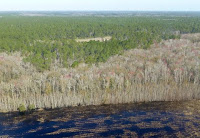According to a new analysis released Tuesday, some of the most threatened forests in America are on the outskirts of iconic southern cities, including Norfolk, Biloxi, Savannah, and Baton Rouge. These last remaining wetland forests, which have helped shape the heritage and identity of these regions, are under imminent threat of destruction by the emerging wood pellet industry in the South - an industry using our forests to feed a growing demand by Europe to burn wood as energy.
In 2013 NRDC sounded the alarm over energy companies that were taking wood from our forests in the southeastern U.S. that could be ground into pellets and burned for energy in large-scale power plants - primarily overseas in Europe. We warned that the massive fuel needs of these energy companies could drive additional logging, threaten sensitive forested ecosystems and increase carbon emissions significantly, contributing to climate change at a time when we need to be rapidly cutting our carbon pollution.
Over the course of the last two years, this trend has grown beyond even our worst expectations. In 2013, the United States exported nearly 3.2 million tons of wood pellets to large-scale power plants in the EU. This has skyrocketed since and could reach as high as 70 million tons by 2020. Together, eight states in the southeastern United States--Alabama, Florida, Georgia, Louisiana, Mississippi, North Carolina, South Carolina, and Virginia--now make up the top exporting region for wood pellets to the European Union. The United Kingdom, the Netherlands, and Belgium are the top importers.
While Wood pellet manufacturers and their major customers claim that pellets from these mills are composed entirely of sawdust and other mill residues, tree trimmings, and diseased or "problem" trees not suitable as timber, studies have concluded that logging residuals alone are unlikely to meet biomass fuel market demands and that healthy, whole trees (e.g., pulpwood) will be needed. Our research, along with the research of other organizations, shows that the harvest of whole trees is already taking place.
In light of this explosive growth, NRDC undertook a first-of-its-kind analysis to assess the potential scale of the threat from these wood pellet mills to some of the most biologically rich wetland forests in the United States - known as bottomland hardwood forests. Our report reveals that millions of acres of these vulnerable forests are in the bull's-eyes of existing and proposed wood pellet mills' potential sourcing areas. Working with the Conservation Biology Institute (CBI), we compiled data showing the geographic nexus between the region's unprotected bottomland hardwood forests and existing and proposed wood pellet manufacturing facilities, placing the threats to these forests in stark visual relief.
Bottomland hardwood forests in the southeast U.S. are not planted forests (i.e., plantations) - which are fast growing trees typically cultivated and fertilized like crops. Instead, bottomland hardwoods are natural, slow-growing forests that occur in stream and broad river floodplains in a mixed canopy of trees - such as towering bald cypress and swamp tupelo, red maple, green ash, American elm, and black gum, as well as numerous species of oak trees. The trees in these forests can live for hundreds of years, are an integral part of the regions' cultural heritage, deliver important ecosystem services to local communities - such as flood control - and provide critical habitat to a host of rare and imperiled species like the Louisiana Black bear and numerous songbirds.
Read more at Bioenergy in Europe Threatens North American Wetland Forests

No comments:
Post a Comment